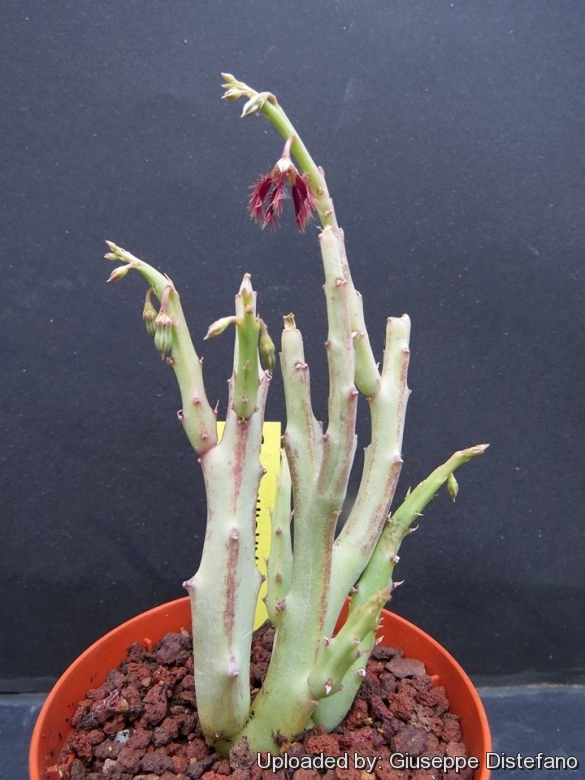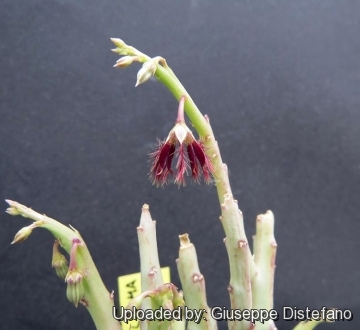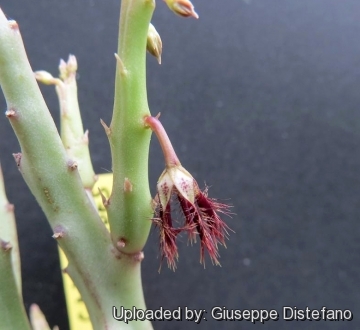




Your support is critical to our success.
Accepted Scientific Name: Caralluma fimbriata Wall.

Origin and Habitat: Arabian Peninsula, North and South Yemen. Caralluma subulataSN|31346]]SN|31346]] is quite widespread in the western and southern coastal plains, lower foothills of the Tihama plain and and highlands from near sea level to 1500 m altitude. It occurs among Salvadora shrubs along the road between Al Lith and Adam with a single population (now extinct) near Wadi Kharar at the northern base of the Taif escarpment. Another small population, also extinct, occurred near Farasan village. It is most abundant from near the base of the Al Abna descent, (where a yellow coloured form was observed but not photographed as my camera was in the car some distance away) between Baljurshi and Namrah and at intervals along the road to Muhayl. Scattered populations also occur near Al Hagu the road to Rayth, and between Sabiya and Jabal Fayfa. Although the stems are not. grazed the plants usually shelter under acacias and in recent years many populations have succumbed to trampling and have either decreased in size or become extinct., and probably extends to Hadramout.
Habitat and ecology: Caralluma subulataSN|31346]]SN|31346]] grows in mainly on gravelly sand under acacias.
Synonyms:
- Caralluma subulata (Forssk.) Decne.
- Stapelia subulata Forssk.
Description: Caralluma subulataSN|31341]]SN|31346]] has a superficial resemblance to Caralluma edulisSN|31346]]SN|33099]] but the slender erect branched stems are always bright green, are not rhizomatous and the flowering apex is not deciduous; the nodding hair-fringed flowers are a deep purple-red with apical tufts of hairs.
Taxonomic notes: Caralluma subulataSN|31341]]SN|31346]] from the Arabian Peninsula, and its African counterpart, Caralluma dalzieliiSN|31341]]SN|33098]], show a very great similarity with Caralluma adscendensSN|33098]]SN|31341]] var. fimbriata from India. Bruyns (1992), has already been put these three taxa into synonymy broadening Caralluma adscendensSN|31346]]SN|31341]] var. fimbriata geographical distribution. This could be taken to indicate that the differences such as round and acute angles varieties merit formal recognition at least as subspecies.
Caralluma subulataSN|33099]]SN|31346]] (Arabian populations) differs from Caralluna adscendens by:
Stems: 3 - 15 cm long, slender, erect, branched, always bright green, not rhizomatous and the flowering apex is not deciduous. The stipular rudiments reduced to lateral small bunches of trans-lucent thick minute hairs.
Flowers: Short-stalked, deep purple-red, nodding, hair-fringed. Corolla inside whitish, horizontally striped with wine-red (Yemen) or dark purple (Saudi Arabia). Corolla-tube inside finely hairy, hairs whitish, crinkled. Corolla-lobes inserted at an acute angle on the corolla (more openly spreading in Caralluma adscendensSN|31346]]SN|31341]] var. fimbriata) lanceolate, acuminate, narrowed towards the base, wine-red or dark purple in the middle, partly to strongly hairy, margin densely covered with long soft purple hairs. Hairs dark pink, 5 5 mm, thick, spreading, corolla tips green, glabrous; appendages of the corolla-lobes sometimes with a small tip between them. Outer corona lobes 3-toothed, the central tooth lanceolate.
Subspecies, varieties, forms and cultivars of plants belonging to the Caralluma adscendens group
- Caralluma adscendens (Roxb.) Haw.: (var. adscendens) Stems edges rounded or sharp; Tubrcles blunt, protruding, horizontally spreading; Flowers drooping; Corolla green, dotted with purple, lobes brownish, spreading outwards, glabrous. Distribution: widespread in India, Ceylon and Burma.
- Caralluma adscendens var. attenuata (Wight) Gravely & Mayur.: Tubercles strongly bent upwards; Flower not quite as drooping as in var. adscendens and var. fimbriata; Pedicel horizontally spreading; Corolla 1.5 cm in diameter, hairy. Distribution: widespread in Indian sub-continent.
- Caralluma adscendens var. carinata Gravely & Mayur.: stem often unhranched, edges acute; Tubercles as in var. attenuata; Flowers erect; Pedicel horizontally spreading; Corolla purple, lobes light maroon banded with yellow. Intermediate between var. attenuata and var. fimbriata in habit. Distribution: India.
 Caralluma adscendens var. fimbriata (Wall.) Gravely: Stems (at least close to the base) with rounded edges: Tubercles as in var. attenuata; corolla rather small, similar to var. attenuata. Distribution: India, Sri Lanka and Burma.
Caralluma adscendens var. fimbriata (Wall.) Gravely: Stems (at least close to the base) with rounded edges: Tubercles as in var. attenuata; corolla rather small, similar to var. attenuata. Distribution: India, Sri Lanka and Burma. - Caralluma adscendens var. geniculata Gravely & Mayur.: stems ascending-erect, occasionally branched. Tubercles indistinctly set off. Pedicel ascending or horizontally spreading. Corolla yellow striped with dark-brown, tube opening widely. It is more related to Caralluma bhupinderiana. Distribution: India.
- Caralluma adscendens var. gracilis Gravely & Mayur.: Stems very slender and strongly branched with acute edges; inflorescence with 2 erect Flowers; Pedicels long, slender, ascending. Corolla lobes strongly revolute. Distribution: India.
- Caralluma dalzielii N.E.Br.: Distribution: Africa North of the equator (Sahelian zone in Africa east to Somalia).
 Caralluma subulata (Forssk.) Decne.: Distribution: Arabian Peninsula.
Caralluma subulata (Forssk.) Decne.: Distribution: Arabian Peninsula.
Bibliography: Major references and further lectures
1) Plowes, D. (1995). “A reclassification of Caralluma R. Br. (Stepelieae: Asclepiadaceae)”. Haselotnia 3: 49–70.
2) Plowes, D. (2011). “When is a Caralluma not a Caralluma?” Asklepias 107: 3–22.
3) Gilbert, M.G. (1990). “A review of Caralluma R. Br. and its segregates”. Bradleya 8: 1–32.
4) S. Karuppusamy “Notes on Caralluma adscendens (Roxb.) Haw. var. attenuata (Wight) Grav. & Mayur. (Apocynaceae: Asclepiadoideae)” Journal of Threatened Taxa | www.threatenedtaxa.org | 26 August 2014 | 6(9): 6282–6286
5) Umberto Quattrocchi “CRC World Dictionary of Medicinal and Poisonous Plants: Common Names, Scientific Names, Eponyms, Synonyms, and Etymology” (5 Volume Set) CRC Press, 19 April 2016
6) Schmelzer, G.H. & Gurib-Fakim, A. “Medicinal plants 2” PROTA, 2013
7) Focke Albers, Ulrich Meve “Illustrated Handbook of Succulent Plants: Asclepiadaceae” Springer Science & Business Media, 06 December 2012
8) Alain Campbell White, Boyd L. Sloane “The Stapelieae”, Volume 1 Typography and printing by S. E. Haselton at Abbey San Encino Press, 1937
9) “Arab Gulf Journal of Scientific Research: Agricultural and biological sciences”, Volume 6
Arab Bureau of Education for the Gulf States, 1988
10) British Cactus & Succulent Journal, Cactus & Succulent Society, 2001
11) Candollea, Conservatoire botanique., 1998

Caralluma subulata Photo by: Giuseppe Distefano

Caralluma subulata Photo by: Giuseppe Distefano
Cultivation and Propagation: Caralluma subulataSN|31346]]SN|31346]] is a relatively quick-growing species and not as difficult to cultivate as was originally thought. It can stand drought for quite a period, which is the only time when it loose its leaves. Keep dry in Winter. Water a little more than other succulents in Summer.
| Your Actions | |
|---|---|
| Back to Caralluma index | |
| Back to Asclepiadaceae index | |
 |
Back to Succulents Encyclopedia index |
Privacy stantement - Terms and conditions - How to cite - About us - Feedback - Donate




